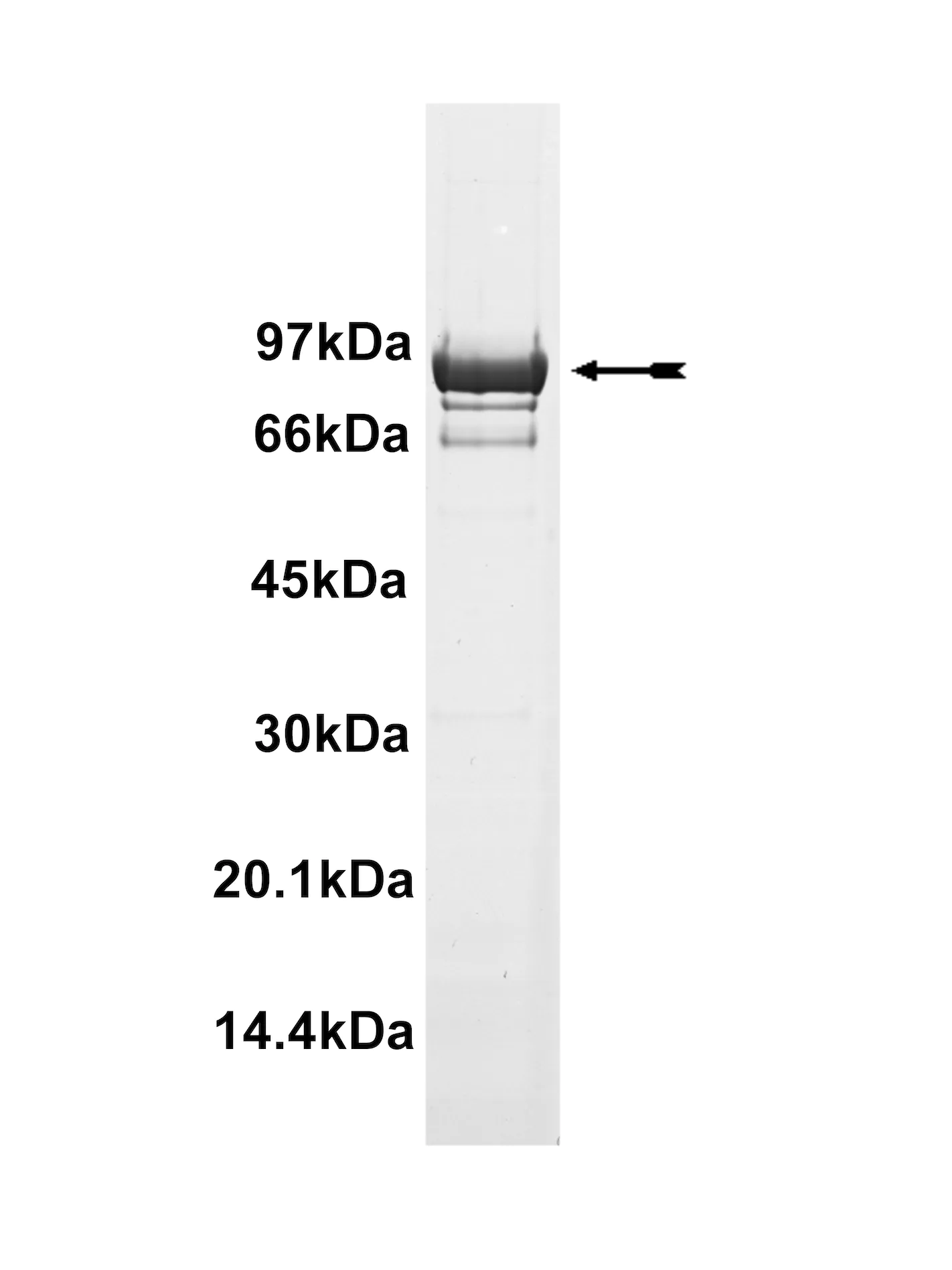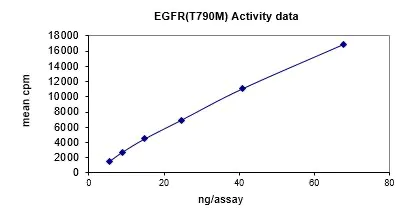EGFR (T790M), active Human Recombinant Kinase Protein
N-terminal GST-tagged recombinant, human EGF receptor amino acids 696end containing the mutation T790M.
Biological information
Background
EGFR (Epidermal Growth Factor Receptor), also known as ErbB1 or HER1, is a transmembrane receptor protein that belongs to the family of receptor tyrosine kinases. It is involved in a variety of cellular processes, including cell growth, proliferation, differentiation, and survival. EGFR is activated by binding to specific ligands, such as epidermal growth factor (EGF) or transforming growth factor alpha (TGF-alpha), which leads to dimerization of the receptor and autophosphorylation of specific tyrosine residues on the intracellular domain. This activates downstream signaling pathways, such as the MAPK/ERK, PI3K/AKT, and JAK/STAT pathways, which regulate gene expression and other cellular functions. Aberrant activation of EGFR has been implicated in several diseases, including cancer, inflammatory disorders, and neurodegenerative diseases.
Target class
Kinase
Family
TK
Accession number
NM_005228.3; NM_201282.1; NM_201283.1; NM_201284.1
Target Name
EGFR (T790M), active Human Recombinant Kinase Protein
Target Alias
EGFR, ERBB1, ERBB, mENA
Origin
Human
Theori. MW
86 kDa
Affinity tag
GST
Product specifications
Expression system
Expressed by baculovirus in Sf21 insect cells
Purity
Purity 85.2% by SDS-PAGE and Coomassie blue staining.
Purification method
Glutathione agarose affinity chromatography
Sample Buffer
Protein in 50mM
Tris/HCl pH7.5, 300mM NaCl, 0.1mM EGTA, 0.03%
Brij-35, 270mM sucrose, 1mM benzamidine, 0.2mM
PMSF, 0.1% 2-mercaptoethanol. Frozen solution.
Specified activity
Refer to CoA
Application
For Research Only
Storage conditions
6 months at -70°C
Usage disclaimer
For Research Only
Chemical data
Background
EGFR (Epidermal Growth Factor Receptor), also known as ErbB1 or HER1, is a transmembrane receptor protein that belongs to the family of receptor tyrosine kinases. It is involved in a variety of cellular processes, including cell growth, proliferation, differentiation, and survival. EGFR is activated by binding to specific ligands, such as epidermal growth factor (EGF) or transforming growth factor alpha (TGF-alpha), which leads to dimerization of the receptor and autophosphorylation of specific tyrosine residues on the intracellular domain. This activates downstream signaling pathways, such as the MAPK/ERK, PI3K/AKT, and JAK/STAT pathways, which regulate gene expression and other cellular functions. Aberrant activation of EGFR has been implicated in several diseases, including cancer, inflammatory disorders, and neurodegenerative diseases.
Compound name
Kinase
Catalog number
14-725
Molecular formula
CAS
MW
Ka
Percent composition
Product specifications
Physical state
Purity (HPLC 214nm)
Retention time (RP18 HPLC)
CMC
Exact mass
Stability
For Research Only
Solubility structure
Kinase Activity Assay Biological information
Background
EGFR (Epidermal Growth Factor Receptor), also known as ErbB1 or HER1, is a transmembrane receptor protein that belongs to the family of receptor tyrosine kinases. It is involved in a variety of cellular processes, including cell growth, proliferation, differentiation, and survival. EGFR is activated by binding to specific ligands, such as epidermal growth factor (EGF) or transforming growth factor alpha (TGF-alpha), which leads to dimerization of the receptor and autophosphorylation of specific tyrosine residues on the intracellular domain. This activates downstream signaling pathways, such as the MAPK/ERK, PI3K/AKT, and JAK/STAT pathways, which regulate gene expression and other cellular functions. Aberrant activation of EGFR has been implicated in several diseases, including cancer, inflammatory disorders, and neurodegenerative diseases.
Target class
Kinase
Family
TK
Subfamily
Protein Name
EGFR
Protein Alias
EGFR, ERBB1, ERBB, mENA
Accession Number
NM_005228.3; NM_201282.1; NM_201283.1; NM_201284.1
UniProt Number
Gene Name
Gene ID
Gene Aliases
Target Species
Human
Kinase Activity Assay Usage
Product Type
Application
Storage Conditions
6 months at -70°C
Usage disclaimer
Kinase Activity Assay Information
Assay Type
Assay Measures
Biological Information
Background
EGFR (Epidermal Growth Factor Receptor), also known as ErbB1 or HER1, is a transmembrane receptor protein that belongs to the family of receptor tyrosine kinases. It is involved in a variety of cellular processes, including cell growth, proliferation, differentiation, and survival. EGFR is activated by binding to specific ligands, such as epidermal growth factor (EGF) or transforming growth factor alpha (TGF-alpha), which leads to dimerization of the receptor and autophosphorylation of specific tyrosine residues on the intracellular domain. This activates downstream signaling pathways, such as the MAPK/ERK, PI3K/AKT, and JAK/STAT pathways, which regulate gene expression and other cellular functions. Aberrant activation of EGFR has been implicated in several diseases, including cancer, inflammatory disorders, and neurodegenerative diseases.
Target class
Kinase
Family
TK
Accession Number
NM_005228.3; NM_201282.1; NM_201283.1; NM_201284.1
Target Name
EGFR
Target Alias
EGFR, ERBB1, ERBB, mENA
Origin
Human
Theoretical MW
Affinity Tag
GST
Product Specifications
Expression system
Expressed by baculovirus in Sf21 insect cells
Purity
Purity 85.2% by SDS-PAGE and Coomassie blue staining.
Purification method
Glutathione agarose affinity chromatography
Sample Buffer
Specified activity
Refer to CoA
Application
Storage conditions
6 months at -70°C
Usage disclaimer
For Research Only
Biological Information
Background
EGFR (Epidermal Growth Factor Receptor), also known as ErbB1 or HER1, is a transmembrane receptor protein that belongs to the family of receptor tyrosine kinases. It is involved in a variety of cellular processes, including cell growth, proliferation, differentiation, and survival. EGFR is activated by binding to specific ligands, such as epidermal growth factor (EGF) or transforming growth factor alpha (TGF-alpha), which leads to dimerization of the receptor and autophosphorylation of specific tyrosine residues on the intracellular domain. This activates downstream signaling pathways, such as the MAPK/ERK, PI3K/AKT, and JAK/STAT pathways, which regulate gene expression and other cellular functions. Aberrant activation of EGFR has been implicated in several diseases, including cancer, inflammatory disorders, and neurodegenerative diseases.
Target class
Kinase
Family
TK
Accession Number
NM_005228.3; NM_201282.1; NM_201283.1; NM_201284.1
Target Name
EGFR
Target Alias
EGFR, ERBB1, ERBB, mENA
Origin
Human
Theoretical MW
Affinity Tag
GST
Product Specifications
Expression system
Expressed by baculovirus in Sf21 insect cells
Purity
Purity 85.2% by SDS-PAGE and Coomassie blue staining.
Purification method
Glutathione agarose affinity chromatography
Sample Buffer
Specified activity
Refer to CoA
Application
Storage conditions
6 months at -70°C
Usage disclaimer
For Research Only





